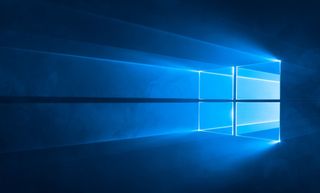Why Microsoft needs to fix its broken tablet mode in Windows 10 (before it's too late)
Microsoft's Windows 10 tablet mode is sub-par, and that's hurting its productivity advantage, leisure computing endeavors and Surface Andromeda hopes.

In 2016, Microsoft achieved OneCore, a unified platform kernel designed to provide a cohesive Windows experience across form factors. From the desktop contexts of Surface Laptop, Surface Studio or Surface Pro (in laptop mode), to augmented reality with HoloLens to the tablet modes of Surface Pro and Surface Go Microsoft is striving to make Windows 10 one OS for all. Conceptually the idea is great.
The execution, however, falls short due to limited developer support, a weak app ecosystem and an underdeveloped touch user interface which all leads to a less than ideal tablet experience. Windows 10 with millions of legacy desktop apps and multiple input modalities is unmatched for productivity. Still, Apple, Google, and Samsung boast superior tablet experiences and more robust app ecosystems. And their quests to make their productivity options more competitive is ever so slowly narrowing Microsoft's entrenched lead.
Ironically, this path to challenging Microsoft's productivity forte was paved by strong touch and ever-evolving tablet experiences. Furthermore, Samsung's Infinity Flex Display that expands a smartphone to a 7.3-inch tablet emphasizes an evolving touch experience that is allowing rivals to progress in a hybrid phone-tablet device category. This accomplishment, also bolstered by a strong tablet UI and ecosystem, beats Microsoft's long-rumored and somewhat similar Surface Andromeda project to market.
An evolved touch and tablet experience has proven critical to Microsoft's rivals advancing their productivity computing strategies as well as bringing ambitious new form factors to market. Microsoft needs to fix its Windows 10 Tablet Mode before it's too late.
Today's smartphones are PCs - and that's an opportunity for Microsoft
Windows diminishing impact

As iPad Pro, Chrome OS, web-based productivity suites and smartphones continue to evolve, the role of powerful Windows desktops becomes less important for many users. Windows PC alternatives are increasingly meeting users computing needs. Unfortunately for Microsoft, this reality highlights the dominant role of touch-centric mobile operating systems like Android and iOS and less powerful desktop OSes like Chrome OS in the everyday lives of users.
These alternative platforms and ecosystems accommodate specific productivity tasks while remaining closely tied to a touch-centric mobile UI. Some users become more convinced that Windows' desktop-centric, touch-unfriendly OS is overkill for many computing activities. This "reassures" users that touch-centric UIs are more relevant for most of their present and future needs. It also bolsters user investment in these platforms and ecosystems as they become more productivity-centric and introduced to users at younger ages (i.e. school).
Get the Windows Central Newsletter
All the latest news, reviews, and guides for Windows and Xbox diehards.
Microsoft is improving its productivity tools like To Do, Microsoft Teams, Office 365, updates to Windows 10 and more. In relation to much-needed improvements to Windows 10 Tablet Mode, however, Microsoft is still falling short. Our deep-dive into the next Windows 10 update 19H1 reveals that Microsoft has not moved the needle at all toward improving Windows 10 tablet mode. That's bad news for Microsoft's present and future touch-centric computing investments.
5 things Microsoft can do to improve Windows 10 Tablet Mode
Microsoft is hiding its tablet behind productivity

Microsoft recently launched Surface Go as "a Surface for everyone", which is also a Surface Pro in almost every way except for its smaller size. Unlike Surface Pro's "most versatile laptop" productivity positioning Surface Go is positioned as a leisure tablet.
Microsoft is pushing Surface Go as the Surface that is always with you for watching videos, listening to music and surfing the Web. This tablet focus seems bold, brave or perhaps a little out of touch considering Windows 10's comparatively poor tablet ecosystem and experience.
Perhaps Microsoft's marketing focus on watching videos, web surfing and listening to music is supported by data as most used tablet activities. If so perhaps that emboldened Microsoft to push a tablet, supported by its productivity messaging, against better tablets that are not as good at productivity. Either way, Microsoft is hiding its tablet weakness behind its productivity forte with Surface Go and Surface Pro while doing nothing to improve its touch-centric tablet experience.
For Samsung, Google and Apple the beat goes on
Meanwhile, Samsung is advancing its mobile computing strategy into a hybrid phone-tablet via its Infinity Flex Display supported by its successful touch UI and ecosystem. Samsung's One UI supplements the experience.
And Google's recently announced native Android support for flexible displays provides a foundation for touch-centric, context conforming mobile computing:
We just announced support for foldables at #AndroidDevSummit, a new form factor coming next year from Android partners.
Android apps run seamlessly as the device folds, achieving this form factor's chief feature: screen continuity. pic.twitter.com/NAfOmCOY26We just announced support for foldables at #AndroidDevSummit, a new form factor coming next year from Android partners.
Android apps run seamlessly as the device folds, achieving this form factor's chief feature: screen continuity. pic.twitter.com/NAfOmCOY26— Android Developers (@AndroidDev) November 7, 2018November 7, 2018
Furthermore, Apple is rumored to be working on a folding phone concept which if it launches will also take advantage of a mature touch UI and mobile ecosystem. Microsoft is falling way behind here.
Without a mature tablet mode Microsoft:
- Is slowly losing ground to productivity scenarios fueled by less powerful mobile OSes.
- Does not offer a competitive slate tablet experience.
- Is being beaten to market with hybrid mobile form factors that bridge phone and tablet categories.
Tablet mode is Surface Go's biggest weakness
Will Windows Core OS fix things … next year?
Microsoft's Windows CoreOS is rumored to be a "more" modular version of Windows and that can be tailored by OEMs to specific devices for specific experiences. CShell is a UI that will provide a seamless experience between device states.
Perhaps Microsoft is reserving advances in Windows 10 tablet mode for improvements that are planned for Windows 10 CoreOS in 2019. If so that could improve the UI experience. Microsoft still needs to build an app ecosystem, likely through PWAs, Project Centennial and developer support to round out the Windows 10 tablet experience to coincide with Windows CoreOS and ideally a Surface Andromeda 3-in-1 (phone-tablet-PC) .
That would take an aggressive commitment to its mobile computing touch experiences, however, that Microsoft has yet to prove it has.
Jason L Ward is a columnist at Windows Central. He provides unique big picture analysis of the complex world of Microsoft. Jason takes the small clues and gives you an insightful big picture perspective through storytelling that you won't find *anywhere* else. Seriously, this dude thinks outside the box. Follow him on Twitter at @JLTechWord. He's doing the "write" thing!
